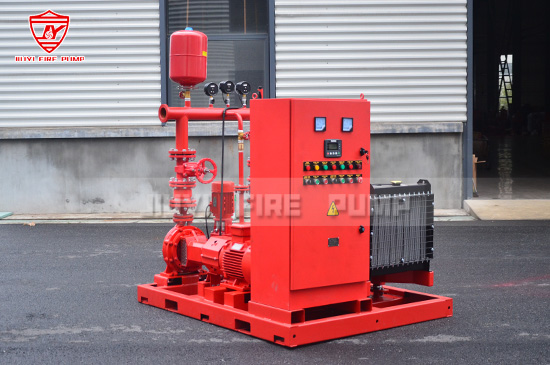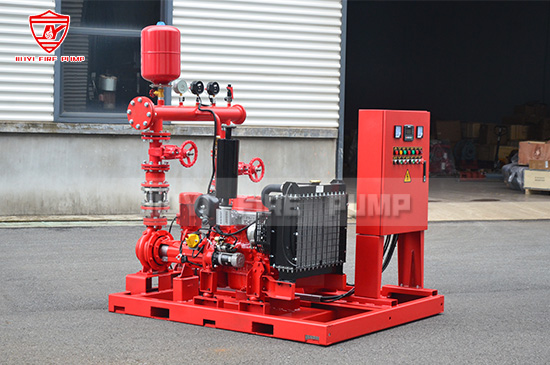Fire pumps are the heart of a fire protection system, designed to provide sufficient water pressure and flow in emergencies. However, fire pumps are not immune to problems like all mechanical equipment. A malfunctioning fire pump can lead to catastrophic consequences during a fire event, which makes it crucial for facility managers, engineers, and building owners to understand the most common issues and how to prevent them.
This article will explore the typical problems fire pumps face, their causes, and proven solutions that help maintain reliability and compliance with standards such as NFPA 20 and UL/FM requirements.

One of the most common and concerning problems is when the fire pump does not start during a fire emergency or test run.
Electrical supply issues such as blown fuses, tripped breakers, or inadequate power.
Battery failure in diesel engine fire pumps.
Controller malfunction due to damaged relays, loose connections, or faulty programming.
Improper testing or maintenance leading to unnoticed issues.
Perform regular inspection and testing according to NFPA 25.
Replace batteries on diesel fire pumps every 2–3 years or as per manufacturer guidelines.
Keep a logbook of fire pump tests to track anomalies early.
Ensure backup power supply reliability for electric fire pumps.
Cavitation occurs when the pump does not get enough water at the suction side, causing vapor bubbles that collapse violently inside the pump.
Low suction pressure due to blocked strainers or insufficient water supply.
Improper pump installation with inadequate suction piping design.
High pump speed exceeding design conditions.
Loud knocking or rattling noises.
Severe damage to impellers.
Reduced pump efficiency and flow.
Ensure suction piping design follows NFPA 20 standards.
Clean and inspect strainers regularly.
Confirm that the water supply (tank or city main) provides adequate volume and pressure.
Overheating can shorten the life of the pump and cause unexpected failures.
Continuous operation without demand (often due to leaks or pressure fluctuations).
Poor lubrication or bearing failure.
Blocked cooling water lines in diesel engine fire pumps.
Regularly test automatic pressure relief valves.
Check for leaks in fire protection systems that cause pumps to run unnecessarily.
Maintain proper lubrication schedules.
Inspect cooling water piping for clogs or corrosion.
A fire pump may run but still fail to deliver the required water pressure or flow.
Impeller wear or damage reducing pump performance.
Clogged suction lines or strainers restricting water supply.
Air leaks in suction line.
Incorrect pump sizing during system design.
Conduct periodic flow tests to ensure performance matches specifications.
Replace worn impellers when efficiency drops.
Recalculate system demand to confirm pump size is appropriate.
Repair leaks and maintain strainers clean.
The jockey pump plays a vital role in maintaining system pressure and preventing the main fire pump from running unnecessarily. When the jockey pump malfunctions, it can cause frequent cycling of the fire pump.
Incorrect pressure settings in controllers.
Worn-out jockey pump components.
Leaks in sprinkler or standpipe systems.
Adjust cut-in and cut-out settings according to NFPA guidelines.
Repair or replace faulty jockey pumps.
Inspect and seal leaks in the piping system.
Controllers act as the brain of the fire pump, starting the system when pressure drops.
Corroded electrical connections.
Faulty sensors or pressure switches.
Improper programming during installation.
Inspect controllers regularly and test pressure switches.
Replace corroded wiring and maintain moisture-free environments.
Work with certified professionals for installation and programming.
Diesel-driven fire pumps have unique problems compared to electric pumps.
Battery or charging system failure.
Fuel contamination or insufficient fuel supply.
Cooling water blockage.
Exhaust system problems leading to overheating.
Regularly test starting batteries and replace as needed.
Ensure fuel storage tanks are clean and topped up.
Inspect and flush cooling systems.
Schedule professional servicing according to NFPA 25.
Even with a well-functioning pump, piping issues can compromise system performance.
Air pockets in suction lines.
Pipe blockages due to corrosion or foreign objects.
Incorrect pipe sizing leading to high friction losses.
Design suction piping with minimal bends and correct diameters.
Install air release valves where needed.
Clean and maintain discharge lines regularly.
Water, combined with lack of maintenance, can cause corrosion of pump parts and piping.
Reduced flow due to pipe scaling.
Weakening of pump casing.
Increased risk of leaks and failures.
Use corrosion-resistant materials where possible.
Apply protective coatings.
Conduct regular inspections and replace rusted parts promptly.
Sometimes, the problem is not mechanical but operational.
Skipping weekly fire pump tests required by NFPA 25.
Improperly trained personnel handling fire pumps.
Delaying preventive maintenance until major issues occur.
Establish a strict maintenance schedule.
Provide training programs for operators and facility staff.
Partner with professional fire pump service providers.

Fire pumps are critical to life safety, and even small issues can lead to major consequences during an emergency. The most common problems—such as failure to start, cavitation, overheating, inadequate flow, controller malfunctions, or diesel engine issues—can all be avoided with proper design, installation, and preventive maintenance.
For building owners, facility managers, and fire protection professionals, the key is early detection and proactive care. By following NFPA 20 and NFPA 25 standards, conducting regular testing, and working with certified fire pump manufacturers, you can ensure that your fire pump system remains reliable when it matters most.